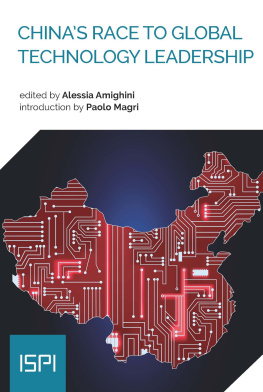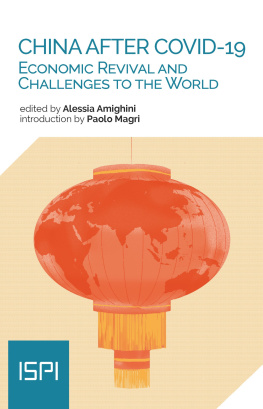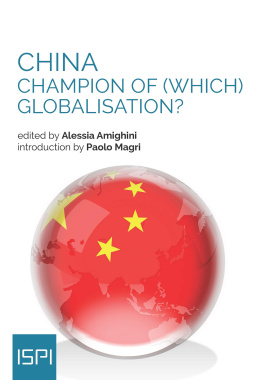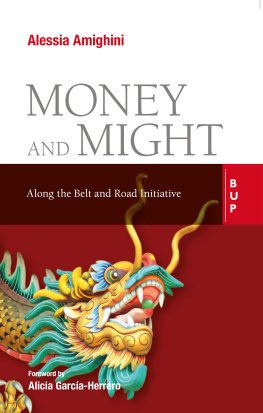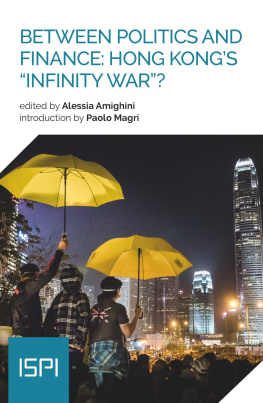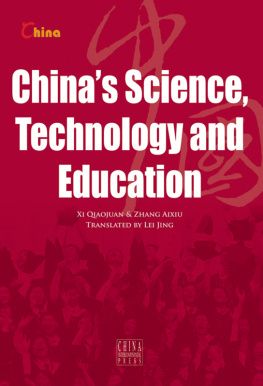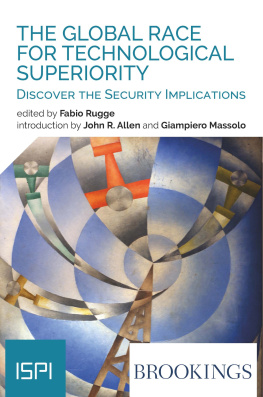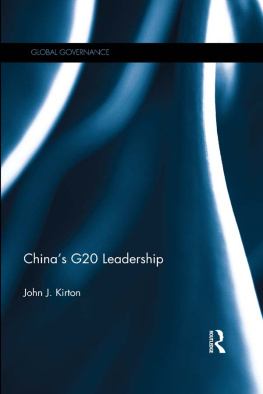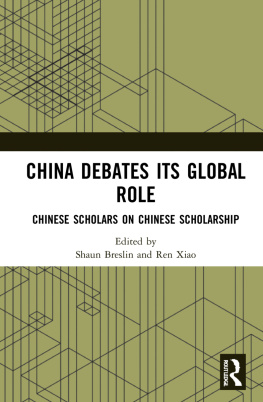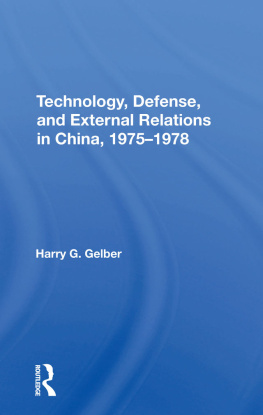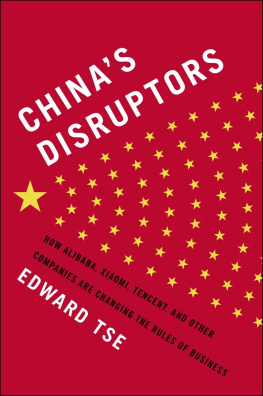2019 Ledizioni LediPublishing
Via Alamanni, 11 20141 Milano Italy
www.ledizioni.it
Chinas Race to Global Technology Leadership
Edited by Alessia Amighini
First edition: May 2019
Cover image created by Diana Orefice
The opinions expressed herein are strictly personal and do not necessarily reflect the position of ISPI.
Print ISBN 9788867059614
ePub ISBN 9788867059911
Pdf ISBN 9788867059928
DOI 10.14672/67059614
ISPI. Via Clerici, 5
20121, Milan
www.ispionline.it
Catalogue and reprints information: www.ledizioni.it
Introduction
Last December the Chief Financial Officer of the leading Chinese telecommunication company Huawei was travelling from Hong Kong to Mexico when she was arrested while changing flights at Vancouver Airport by the Canadian authorities acting on an extradition request from the United States. Mengs arrest and detention are a significant development in China-US relations, marking a dramatic change in the relationship between Beijing and Washington.
The current trade war between the US and China looks like a small element in a much larger contest over world leadership in which China plays the part of the ascending challenger that seeks to upset the existing balance of power. Chinas weapons of choice are technology and innovation: it is making a frontal assault on the US in a sector that has traditionally been Americas forte .
Imperial China was recognised as an inventor of advanced technology, and its best-known inventions (the magnetic compass, gunpowder) were essential factors in the countrys rising influence, giving it a significant advantage over other regional powers. Despite this technological background, however, Communist China has so far primarily opted for a different path: its preferred approach has been to acquire Western technology as a way of boosting its own innovation and growth. The means China employs to this end have often been denounced as barely legal: the rules imposed on access to the Chinese market, for instance, forced American multinationals to set up joint ventures with Chinese enterprises, which then demanded technology transfers as a part of the deal. Although those rules are set to become less stringent in January 2020, they were in place for decades and China will undoubtedly continue to feel the benefit. The Thousand Talents Plan unveiled in 2008 was another blatant example of the same strategy: targeting Chinese academics outside the country, it offered them state subsidies and tenured positions in Chinas top universities if they would set up research programmes in China on the basis of the scientific knowledge they had acquired in their work abroad.
Acquisitions of technology became more prominent as China turned out to be the second biggest global economy. Chinese investments in the West have targeted high-tech companies: in 2016, Chinese foreign investments in the technology sector reached US$24.13 billion, and included the acquisition of Kuka Robotics, a German pioneer of Industry 4.0, by Guangdong Midea Consumer Electric. Such investments are perfectly in line with Premier Li Keqiangs plan entitled Made in China 2025, which subsidises mergers and acquisitions of Western companies with the objective of strengthening Chinas chains of production.
Whatever the preferred strategy, Beijings efforts are paying off. Chinas top telecommunication providers Huawei and ZTE, for instance, were the first to develop the technology needed for the commercial application of 5G.
Against this backdrop, the US is keen to point out that China has been unfair in its path towards technological leadership while not moving towards democracy as expected even after forty years of engagement with Western powers. Yet despite President Trumps tariffs, the extensive linkage between China and the US has created such highly intertwined strategic and economic benefits for both countries that disastrous results would inevitably ensue for each of them if they were forced apart.
China is not only acquiring technology; it now also has ambitions concerning the regulation of international trade and global governance generally. In other words, China is challenging the liberal order out of which it emerged as a global player. Just what a China-led global order would look like is still unclear, and the uncertainties are even more significant since the technology sector has rules of its own. The inherent dangers of technology need to be meticulously assessed, as they have the potential to alter the core values of modern societies, with which they are inextricably entwined.
This need is becoming more pressing as Chinas technological rise is no longer a thing of the future, but a present reality: there are other pointers to it besides leadership in the commercial application of 5G technology. The biggest of all start-ups, for instance, is the financial arm of Alibaba (Ant Financial), with an estimated value of over US$150 billion; and of the top fifty unicorn companies (start-ups valued at US$1 billion or more), 26 are Chinese and 16 American. Europe does not make the list at all. In terms of growth, moreover, while top US tech companies grew 26% between 2017 and 2018, their Chinese counterparts grew at 33%. This gap between East and West is growing wider and wider, and it would be unwise to ignore it. Most recently, Google has taken action to fill this gap by precluding Huaweis access to Android, the system on which most Huawei smartphones operate. Google acted upon a ban from the US government that demands American telecommunication companies not to install foreign equipment that may threaten national security. Less than a day later, the US granted a temporary general licence to the Chinese telecom provider, so as to reduce the damage that an abrupt halt would inflict to US companies and organisations that run their operations on Huaweis products and to limit repercussions from China.
Last years ISPI report was entitled China, Champion of (Which) Globalisation?. It focused on the kind of globalisation that Chinas growing influence would bring to the world, examining the changes, rules and standards implied by a China-led economic system. This year it is time to investigate what part technology will play in Chinas rise.
The present ISPI report tackles the question by looking at various practical aspects of Chinas challenge to US technological leadership and by considering its implications for the US, Europe and last but not least the entire global liberal order. While the trade war is a weapon in a wider technological contest, the two powers race for world leadership in technology is a battle between two different approaches to economic growth. In China the Communist Party remains the main provider of innovation: it sets the standards for businesses to follow, and the objectives. In the West, on the other hand, governments have a more peripheral role since they are only in charge of providing public goods; businesses are free to follow the direction indicated by markets. Chinas state-oriented economic model is rooted in a practical protectionism that challenges the Western principle of free trade and the multilateral global economy championed by the World Trade Organization.
In her first chapter, Alessia Amighini attempts to answer the baseline question of whether China has what it takes to strip the US of the title of global technology leader. Amighini stresses that despite the long series of investments towards innovation enacted by the Chinese leadership since the 1970s, the country has not yet found a way to advance disruptive technologies to the same extent of incremental technologies. This inability is a substantial loss, as it is disruptive technologies that have the potential to reform the global economy, thus offering a considerable advantage to their proponents. The challenges that Amighini identifies as the sources of Chinas struggle over technology advancements mainly point to three domains of Chinas economic system: institutional, organisational and social barriers. The reform of these domain is, according to Amighini, key for the country to assume full control of the global technology sector.


